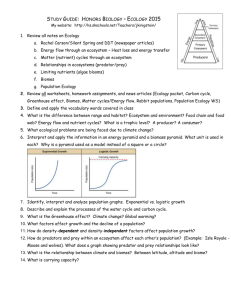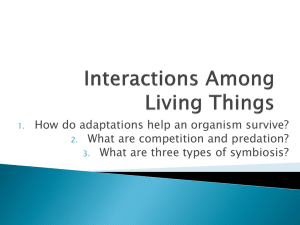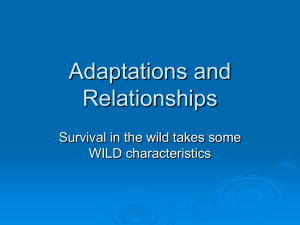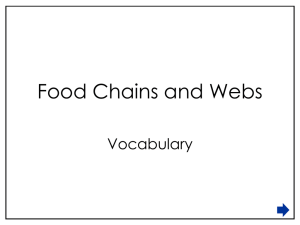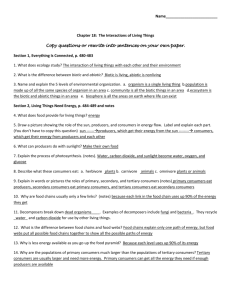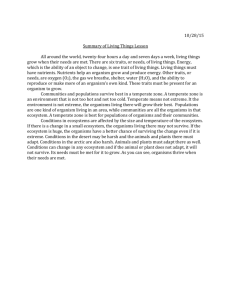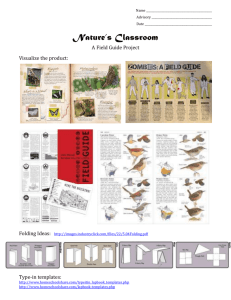Science 7 Ecosystems Learning Guide
advertisement
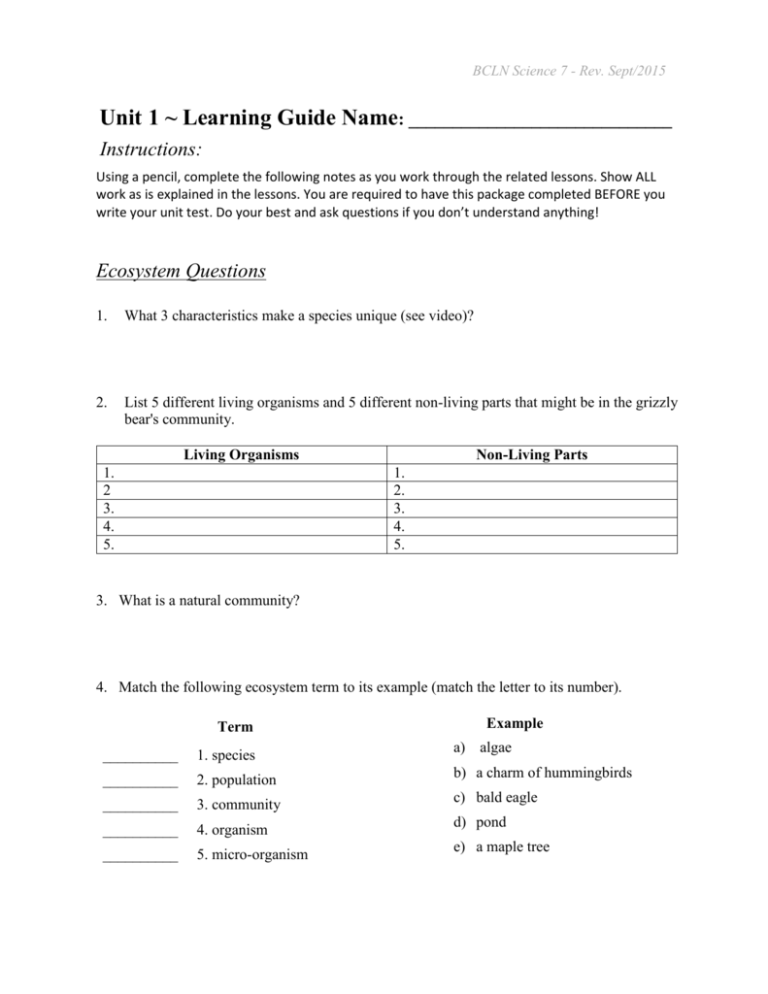
BCLN Science 7 - Rev. Sept/2015 Unit 1 ~ Learning Guide Name: ______________________________ Instructions: Using a pencil, complete the following notes as you work through the related lessons. Show ALL work as is explained in the lessons. You are required to have this package completed BEFORE you write your unit test. Do your best and ask questions if you don’t understand anything! Ecosystem Questions 1. What 3 characteristics make a species unique (see video)? 2. List 5 different living organisms and 5 different non-living parts that might be in the grizzly bear's community. Living Organisms 1. 2 3. 4. 5. Non-Living Parts 1. 2. 3. 4. 5. 3. What is a natural community? 4. Match the following ecosystem term to its example (match the letter to its number). Term Example __________ 1. species a) algae __________ 2. population b) a charm of hummingbirds __________ 3. community c) bald eagle __________ 4. organism d) pond __________ 5. micro-organism e) a maple tree BCLN Science 7 - Rev. Sept/2015 Sub-Ecosystems and Biomes Questions 1. What is the significant difference between an Ecosystem and a Biome? 2. By examining the map Biogeoclimatic Classification Systems in British Columbia, what kind of biomes would be expected on the coast of B.C. near Vancouver Island and in the Central Interior of BC? Habitats Questions 1. How do the needs differ for plants and animals? Use this Venn diagram to show their similarities and differences. BCLN Science 7 - Rev. Sept/2015 2. List 4 organisms (plants and animals) you might find in each of these habitats. Arctic Desert Pond Tropical rainforest 1._______________ 1._______________ 1._______________ 1._______________ 2. ______________ 2. ______________ 2. ______________ 2. ______________ 3. ______________ 3. ______________ 3. ______________ 3. ______________ 4. ______________ 4. ______________ 4. ______________ 4. ______________ Limiting Factors Questions 1. How do the 4 limiting factors affect an organism's ability to survive? Explain and give two examples. Interactions Questions 1. What is competition in an ecosystem and how does it affect living organisms. Give an example. 2. How does the bird eating ticks mutually benefit the Impala? 3. Use the ""Predator Prey Relationship Graph" to explain how the predator prey relationship creates a balance in the environment? BCLN Science 7 - Rev. Sept/2015 Answer Key Ecosystem Answers: 1. A group of the same species will reproduce among themselves, have similar characteristics, and have similar behavior. 2. Living Organisms: Grizzly bear, salmon (fish), birds, any plant species, any other and lizards Non-Living Parts: Rocks, Soil, Water, Dead Trees, and Mountains 3. A natural community consists of all of the plants and animals interacting with their localized area such as swamps, hillsides, or forests. 4. An ecosystem is made up of interactions among living and nonliving things in an environment. 5. 1. Species (c bald eagle), 2. Population (b a group of hummingbirds), 3. Community (d pond), 4. Organism (e maple tree), Micro-organism (a algae) Sub-Ecosystems and Biomes Answers: 1. A biome is classified by its climate and vegetation. 2. The Biomes of Coast British Columbia are mainly Coastal Western Hemlock and the Central Interior's main Biomes are Interior Douglas Fir. Habitats Answers: 1. -produce own food -carbon dioxide -consume food -sunlight -water -oxygen -shelter 2. Some of the different living organism found at these habitats are… Arctic Fox, hawk, owl, seal, sea lion, whale, polar bear, moss, bushes Desert Fox, birds of prey, lizards, scorpions, spiders, cactus, sage Pond Frogs, raccoons, fish, heron, insects, water lily, water weeds, grass Tropical rainforest Monkeys, insects, spiders, frogs, snakes, palm trees, moss, vines BCLN Science 7 - Rev. Sept/2015 Limiting Factors Answers: 1. The 4 limiting factors affect an organism's ability to survive because each organism needs a certain amount to survive, too much or too little and the organism may not grow or it will die. Examples: Some plants may only do well in bright sunlight; others prefer shade. Desert plants need water but they can survive on much less water than many other plants. A plant that thrives in the desert may not do well in a rain forest. Polar bears can survive in colder temperatures. Plants get their nutrients from the soil and different soils have different amounts of nutrients. Interactions Answers: 1. Competition for resources are space, water, and food. If there is not enough of any of these resources then animals cannot survive in their environment. Examples: If trees are too crowded they cannot grow, they will not get enough water, light, or nutrients from the soil. Grizzly bears need a large space and enough food to survive. 2. The bird eats ticks for food and the Impala won't get disease. 3. The predator prey relationship creates a balances because if the prey population is high the predator relationship will increase. As the predators increase so does the prey. The cycle begins again.

